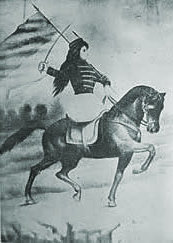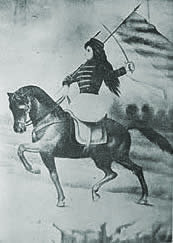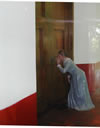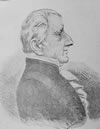
|
Women and Independence in Latin America An exploration of women's involvement in the Latin American Wars of Independence |

|

|
Women and Independence in Latin America An exploration of women's involvement in the Latin American Wars of Independence |

|
Click on one of the images below to see the full-size image
 Calle Ortiz |
 Josefa Ortiz |
 Josefa Ortiz de Dominguez |
 Miguel Domínguez |
 Josefa Ortiz |
 Josefa Ortiz |
Other names: La Corregidora
Gender:Female
Ethnic origen: White
Events:
| 1768 | - | Morelia | - | Not applicable | - | She was born in Morelia. |
| 1770? | - | Mexico City | - | Unknown | - | She and her sister moved here as a child after their parents died. |
| 1789-1791 | - | Morelia | - | Unknown | - | She studied at the Colegio de San Ignacio from 30 May 1789 until 31 March 1791. |
| 1791 | - | Querétaro | - | Unknown | - | She is said to have married Miguel Domíngez, the corregidor of Querétaro. |
| 1791 | - | Querétaro | - | Unknown | - | She moved here with her husband in 1791. |
| 1810 | - | Querétaro | - | Unknown | - | She sent a message to Ignacio Allende that instigated the call to arms in 1810. |
| 1813 | - | Querétaro | - | Patriot | - | She was re-arrested by the royalists. |
| 1816 | - | Mexico City | - | Patriot | - | She was imprisoned in Santa Catalina convent. |
| 1817-1829 | - | Mexico City | - | Patriot | - | She was released from Santa Catalina convent and lived in Mexico City until her death |
| 1829 | - | Mexico City | - | Unknown | - | She died here. |
Connections:
Enlightenment ideasBiography:
She was part of a group who discussed enlightenment ideas in Guanajuato. Led by the Spanish intendant of Guanajuato, Juan Antonio Riaño, the group included Miguel Domínguez, Ignacio Allende, Juan Aldama, Miguel Hidalgo, and Mariano Absalo. (Rodríguez, 160)
She was married to Miguel Domínguez, the Corregidor of Querétaro, and met with José Joaquín de Lizardi and others in favour of independence despite being told not to by the Viceroy. She was imprisoned for 4 years and released only when her husband became blind. Viceroy Apodaca released her for compassionate reasons. Republicans continued to meet at her house to rail against the tyranny of Iturbide. Her statue stands in the Plaza de Santo Domingo, Mexico City and her image features alongside Hidalgo, Morelos etc. each September. This statue was an icon for those seeking women’s suffrage in the 1950s. (Miller, 32)
It is said that she cut words out, stuck them together and sent them to Allende because she knew how to read, but not how to write, because “it was illegal for women to learn to write so they would not be able to compose love letters”. She sent the message that instigated the call to arms in 1810: she overheard that they’d been discovered and managed to get a message to them, even though she’s been locked inside her house by her husband. Doña Josefa’s “bold and audacious” action led to her imprisonment; the Viceroy was advised that Domínguez should be imprisoned too, on the basis that he was responsible for his wife’s actions. (He wasn’t locked up.) (Arrom, 35-36, 296.)
She is listed as a member of the Sociedad de los Guadalupes. (Torre Villar, lxxviii)
She was born in Valladolid, Morelia, around 1768 and studied at the Colegio de San Ignacio de Loyola or the Colegio de las Vizcaínas. She married Miguel Domíngez, the corregidor of Querétaro in 1791 when she was 23. In 1810 she joined conspirators Miguel Hidalgo and Ignacio Allende and told them warned them that the royalists had discovered their cache of weapons. She was arrested by the Spanish authorities and imprisoned in the Convent of Santa Catalina de Siena for 3 years. She died in Mexico City in 1829. (Castañeda, 71)
She was born in Morelia in 1768. Her parents were Juan José Ortiz and Manuela Girón. She was orphaned at an early age and she and her elder sister moved to Mexico City. She studied at the Colegio de San Ignacio from 30 May 1789 until 31 March 1791. She married Miguel Domínguez, Corregidor of Querétaro aged 23 and they moved to Querétaro. She supported independence from Spain in 1809. Miquel i Vergés believes that she influenced her husband to become sympathetic to the independence cause. Domínguez locked her up on the night of 13 September 1810 fearing that she would do something imprudent. She whispered through the locked door to a patriot, Ignacio Pérez that the conspiracy had been discovered and he was able to warn Hidalgo and Allende. She was imprisoned on 16 September 1810 and after a short time was sent to the Convento de Santa Clara. She was released, but imprisoned again in the Convento de Santa Catalina on 16 November 1816. She was freed on Domínguez's request in June 1817. She was designated empress when independence was declared secure by Iturbide and lived in Mexico City until her death in 1829. She was buried in Santa Catalina church. On 10 December 1878 the Congress of Querértaro declared her "Benemérita de la Patria" and her name was inscribed in the session room. In 1900 a statue of her was erected in Santo Domingo, Mexico City. (Miquel i Vergés, 440-441)
Gonzlález Obregón quotes a version of the message she sent to warn the conspirators: "En pos de estas le tras van de prisión y la muerte; mañana serás un héroe ó un ajusticiado; en esta revolución está la pérdida de mi libertad; pero este sacrificio no sería estéril; porque sé que me mandarás en contestación el grito de independencia". (González Obregón, 157)
She was born in Valladolid in 1768 and married the corregidor of Querétaro when she was aged 20. She was arrested on 16 September 1810 and held in the Convento de Santa Clara, Querétaro. When she was arrested she exclaimed, "Tantos soldados oara custodiar una pobre mujer; pero yo con mi sangre les fomaré un patrimonio a mis hijos." She was released shortly afterwards and re-arrested in 1813. She had 14 children, some of whom were not her own. (AGN, 70-71)
References:
Archivo General de la Nación (Mexico)
Domenella, Ana Rosa, and Pasternac, Nora (editor). (1997) Las voces olvidadas: Antologia critica de narradoras mexicanas en el siglo XIX
Arrom, Silvia Marina (1985) The women of Mexico City, 1790-1857
Castañeda, Cecilia (2003) Caudillos mexicanos
González Obregón, Luis (c1952) Los procesos militar e inquisitorial del Padre Hidalgo y de otros caudillos insurgentes
Miller, Francesca (1991) Latin American Women and the search for Social Justice
Miquel i Vergés, José María (1969) Diccionario de Insurgentes
Rodríguez O., Jaime E. (1998) The Independence of Spanish America
Torre Villar, Ernesto de la (1966) Los "Guadalupes" y la Independencia, con una selección de documentos inédittos